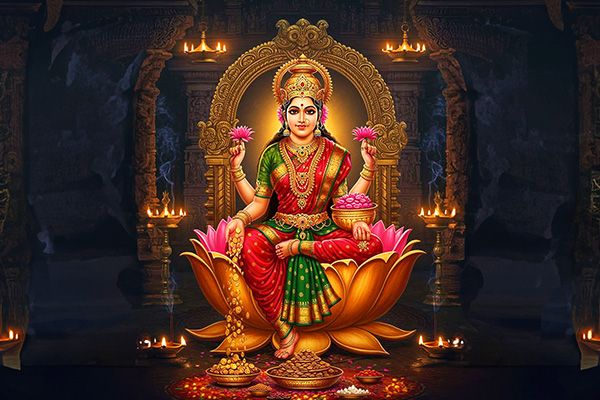
Lakshmi, the radiant goddess of wealth, fortune, beauty, and prosperity, holds a central place in the spiritual and material aspirations of devotees across the world. She is the divine consort of Bhagwan Vishnu and the embodiment of auspiciousness and abundance in all forms; material, spiritual, and emotional. Her presence is not only associated with financial success but also with harmony in relationships, purity of heart, and the blossoming of virtues that lead to holistic well-being. Adorned in red garments and seated on a blooming lotus, Lakshmi represents dynamic energy, grace, and the continuous flow of blessings. Worshiping her with devotion, especially during auspicious occasions like Diwali, opens the path to inner fulfilment and external prosperity, aligning one's life with divine abundance.
Who is Lakshmi Devi?
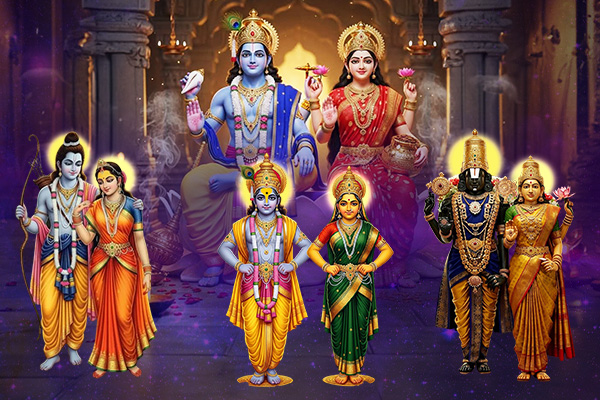
Lakshmi is the Hindu goddess of wealth, prosperity, abundance, and beauty. She holds a revered position in the Hindu pantheon as the consort of Bhagwan Vishnu, the preserver among the trinity of Brahma, Vishnu, and Shiva. As Vishnu accompanies the universe through its cycles of creation, preservation, and dissolution, Lakshmi follows him in every incarnation, manifesting as Sita with Rama, Rukmini with Krishna, and Padmavati with Venkateshwara. She is the divine energy that sustains all forms of growth, success, and fortune. Lakshmi is also one of the Tridevi, alongside Saraswati and Parvati, and is considered the cosmic counterpart of divine action and material fulfillment. Born during the churning of the cosmic ocean (Samudra Manthan), she emerged as the celestial goddess who bestows wealth and auspiciousness on the righteous.
Lakshmi is typically depicted seated or standing on a fully bloomed lotus, symbolizing purity and spiritual power. Her vahana or vehicle is the owl, which represents wisdom and the ability to remain alert in the darkness of ignorance. She is often shown with four arms, each symbolizing dharma (righteousness), artha (wealth), kama (desires), and moksha (liberation). In two of her hands, she holds lotus flowers, while another hand bestows blessings, and the fourth showers gold coins, reflecting her role as the giver of material and spiritual prosperity. Her association with the lotus, gold, and light underscores her essence as the source of divine grace and fortune.
Significance of Lakshmi Devi
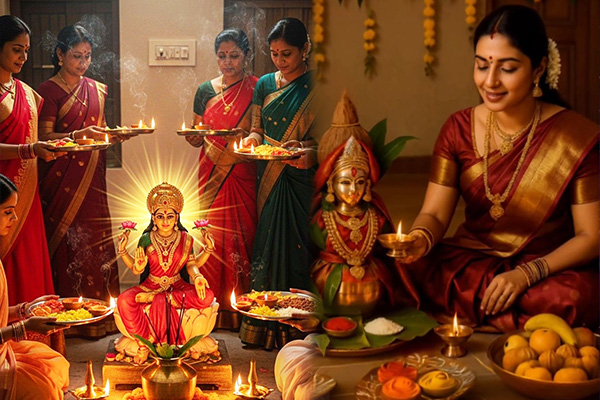
Lakshmi holds deep philosophical and spiritual significance in Hinduism as the embodiment of divine abundance, purity, and auspiciousness. She represents the universal principle of sustenance that nourishes life in all its forms. More than just the giver of material wealth, Lakshmi symbolizes the inner prosperity that arises from righteous living, compassion, and spiritual discipline. Her energy supports the pursuit of dharma and the attainment of moksha, making her presence essential for both worldly success and spiritual evolution. Spiritually, she reflects the harmonious balance between material duties and inner growth, teaching that true wealth lies not only in possessions but also in values, relationships, and self-realization.
Lakshmi is especially revered in Vaishnavism, where she is worshiped alongside Bhagwan Vishnu in temples and homes. In South India, she is venerated as Andal, and in Eastern traditions, such as Shakta sects in Bengal and Assam, she is honoured as a powerful manifestation of Devi. Across India, her worship takes different forms but consistently emphasizes prosperity, well-being, and divine grace. The most important festival dedicated to Lakshmi is Diwali, particularly its third day, which is known as Lakshmi Puja. On this night, devotees light oil lamps and perform elaborate rituals to invite her into their homes, seeking blessings for wealth, harmony, and spiritual upliftment. Other regional festivals include Varalakshmi Vratam in South India and Kojagari Lakshmi Puja in Bengal, reflecting her widespread and deeply rooted significance across diverse Hindu communities.
Iconography & Symbolism
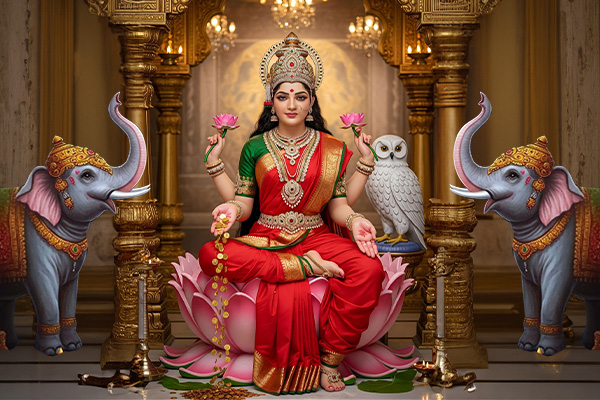
Lakshmi is portrayed as a stunningly beautiful goddess with a calm, benevolent expression that radiates peace and abundance. She is usually depicted with four arms, symbolizing the four goals of human life: dharma (righteousness), artha (wealth), kama (desires), and moksha (liberation). Her hands hold significant items, lotuses representing purity and spiritual enlightenment, gold coins flowing from one hand symbolizing prosperity, and another hand raised in abhaya mudra, offering protection and assurance. Her crown and ornaments sparkle with celestial brilliance, denoting divine status and infinite wealth. She is often shown seated or standing on a fully bloomed lotus, a symbol of detachment, purity, and divine beauty that thrives even amid worldly chaos.
Artistic depictions of Lakshmi in paintings, sculptures, and temple iconography are rich in detail and deeply symbolic. Temples dedicated to Vishnu typically include beautifully carved or painted images of Lakshmi at his side, emphasizing her inseparable role in sustaining the cosmos. South Indian temples often portray her in majestic forms such as
Sridevi and Bhudevi, standing gracefully beside Vishnu. In ancient temple sculptures, she is shown showering coins and flanked by elephants performing abhishekam with water pots, representing royal power, fertility, and spiritual prosperity. These elephants, known as Gajalakshmi motif, are especially common in temple art and architectural elements throughout India.
The colours associated with Lakshmi hold deep symbolic meaning. She is often dressed in red garments, representing active energy, auspiciousness, and the power of transformation. Gold ornaments and accessories highlight her role as the goddess of wealth and divine abundance. Her posture, whether seated or standing, reflects stability, grace, and readiness to bless. Mudras such as varada (boon giving) and abhaya (fear dispelling) are central to her iconography, reinforcing her protective and benevolent nature. The lotus in her hand and beneath her feet signifies spiritual elevation and detachment from the material world, even while being immersed in it.
Origin of Goddess Lakhsmi
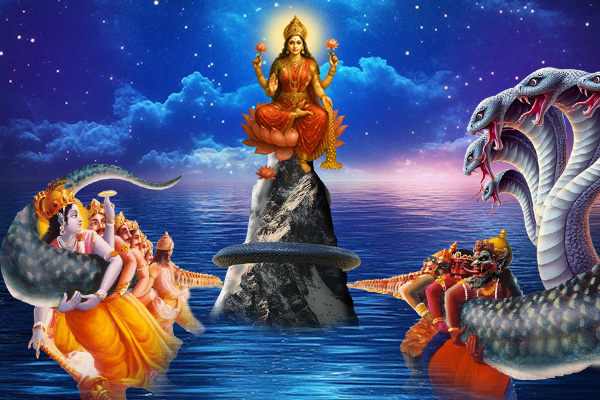
Lakshmi's origin is deeply rooted in Hindu mythology and sacred scriptures, symbolizing her as the embodiment of wealth, prosperity, and auspiciousness.
The Samudra Manthan
One of the most profound narratives of Lakshmi’s origin is rooted in the cosmic event of Samudra Manthan, the Churning of the Ocean of Milk. Described in the Bhagavata Purana, Vishnu Purana, and Mahabharata, this episode represents a divine collaboration and conflict between the Devas and Asuras in pursuit of Amrita, the nectar of immortality. As Mount Mandara was used as the churning rod and Vasuki as the rope, various divine objects and beings emerged from the depths of the ocean. Among them, Goddess Lakshmi manifested resplendently, seated on a blooming lotus, adorned with celestial ornaments and bearing the aura of prosperity and grace. Her appearance marked the restoration of balance and divine order. She chose Bhagwan Vishnu as her eternal consort, symbolizing the inseparable relationship between wealth and its sustainer, thus reinforcing her role as the energy behind preservation and abundance.
In the Vedic corpus, the presence of Lakshmi is firmly established. The Rig Veda, particularly through the Shri Sukta, offers one of the earliest and most authoritative invocations of the goddess. She is invoked as the source of affluence, auspiciousness, nourishment, fertility, and sovereign power. The repeated chants of “Shri” reflect the multifaceted nature of her divine grace. The Atharva Veda continues this reverence, presenting her as the bringer of fortune, purity, and harmony, essential for both worldly prosperity and spiritual growth. In these texts, she is not only associated with material wealth but also with moral virtues, ethical living, and domestic harmony, which were regarded as integral to true prosperity in the Vedic worldview. This dual association
emphasizes her cosmic importance and enduring relevance across all dimensions of human life.
Avatars and Associations in Epics
In Hindu epics, Lakshmi is associated with several avatars, aligning with Bhagwan Vishnu's incarnations:
- Sita: In the Ramayana, Sita, the devoted wife of Bhagwan Rama, is considered an incarnation of Lakshmi, exemplifying virtue and devotion.
- Rukmini: In the Mahabharata, Rukmini, the principal wife of Bhagwan Krishna, is revered as an avatar of Lakshmi, symbolizing love and devotion.
- Padmavati: In South Indian traditions, Padmavati, the consort of Bhagwan Venkateswara (a form of Vishnu), is identified with Lakshmi, emphasizing her role in granting wealth and prosperity.
These associations underscore her integral presence in various narratives, highlighting her as the divine feminine energy accompanying Vishnu in his earthly manifestations.
Legends and Stories
Lakshmi’s Incarnation as Padmavati
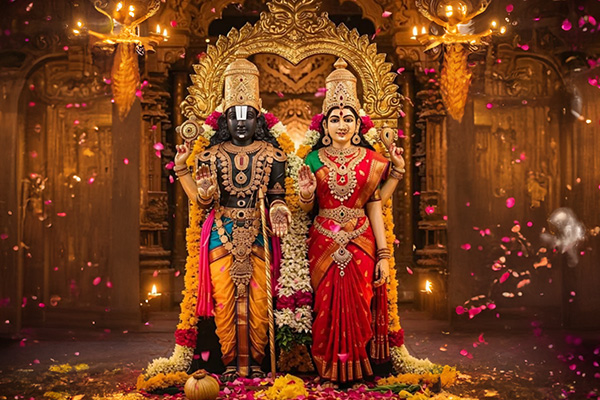
In the Vaishnavite tradition, Goddess Lakshmi incarnated as Padmavati, the daughter of King Akasha Raja of the Chandragiri dynasty. This manifestation occurred to continue her divine companionship with Bhagwan Vishnu, who had descended to Earth in the form of Venkateswara or Srinivasa during the Kali Yuga. The story narrates how Bhagwan Srinivasa, while residing in the Seshachalam hills, encountered Padmavati and fell in love. Their celestial union was celebrated with grand rituals, and Bhagwan Venkateswara took a loan from Kubera, the god of wealth, to fund the wedding. Devotees visiting the Tirumala Venkateswara Temple continue to make offerings, symbolically helping the Bhagwan repay this loan. This legend underlines Lakshmi’s role in sustaining dharma and auspiciousness through divine incarnations aligned with Vishnu’s avatars.
Lakshmi’s Association with Alakshmi
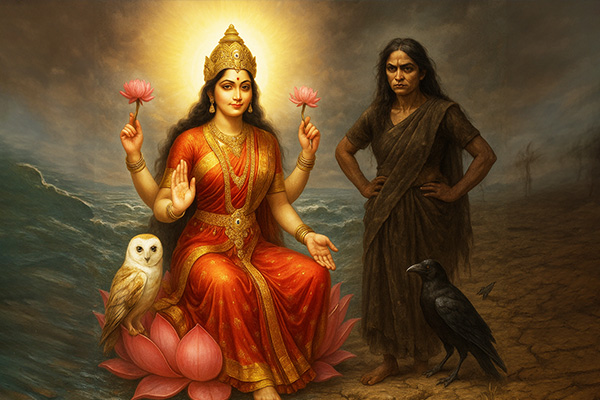
The Samudra Manthan, or the Churning of the Ocean, produced not only celestial treasures but also contrasting energies. Lakshmi, as the goddess of wealth, fortune, and auspiciousness, emerged embodying harmony and abundance. Simultaneously, Alakshmi appeared, representing poverty, conflict, and misfortune. The dual emergence illustrates the cosmic balance of positive and negative forces. Alakshmi is often associated with restlessness, greed, and discord, while Lakshmi signifies stability, generosity, and joy. To ward off Alakshmi, people invoke auspicious energies through cleanliness, sacred chants, and rituals. Lakshmi’s association with the owl emphasizes spiritual alertness. The owl, despite being nocturnal and seemingly inauspicious, symbolizes the ability to see beyond illusion and to guard prosperity with wisdom and vigilance.
Ashta Lakshmi – The Eight Forms of Goddess Lakshmi
Goddess Lakshmi, the divine consort of Lord Vishnu, is revered as the goddess of wealth, prosperity, and fortune. In Hindu tradition, she is worshipped in eight distinct manifestations, collectively known as Ashta Lakshmi. Each form represents a unique aspect of abundance and is invoked for different blessings essential to human life.
The Eight Forms of Ashta Lakshmi
Adi Lakshmi (Primeval Lakshmi)
The primal form of Lakshmi, symbolizing eternal wealth, health, and prosperity. She is worshipped for general well-being and spiritual abundance.
Dhana Lakshmi (Goddess of Wealth)
The bestower of material wealth, money, gold, and riches. Worshipping Dhana Lakshmi ensures financial stability and prosperity in life.
Dhanya Lakshmi (Goddess of Nourishment)
The giver of food, agricultural prosperity, and nourishment. She is worshipped to remove scarcity and ensure abundance of grains and essential resources.
Gaja Lakshmi (Goddess of Strength and Royalty)
Depicted with elephants, Gaja Lakshmi symbolizes power, strength, and royalty. She blesses devotees with authority, dignity, and success.
Santana Lakshmi (Goddess of Progeny)
The granter of children and continuity of family lineage. She blesses families with healthy children, maternal care, and happiness in family life.
Veera Lakshmi (Goddess of Courage)
The embodiment of strength and valour. Veera Lakshmi is worshipped for courage, confidence, and resilience in overcoming life’s challenges.
Vijaya Lakshmi (Goddess of Victory)
She ensures victory in all endeavours, whether in personal struggles, professional pursuits, or spiritual paths. Worshipping her removes obstacles and brings success.
Vidya Lakshmi (Goddess of Knowledge)
The bestower of wisdom, education, and learning. She blesses devotees with intelligence, clarity, and spiritual insight.
Significance of Ashta Lakshmi Worship
Together, the eight forms of Lakshmi represent the complete spectrum of prosperity- spiritual, material, physical, intellectual, and familial. Worship of Ashta Lakshmi is believed to ensure:
- Wealth and abundance
- Health and nourishment
- Strength and authority
- Children and family happiness
- Wisdom and knowledge
- Courage and victory
Devotees often chant the Ashta Lakshmi Stotram and offer prayers to invoke the blessings of all eight forms, ensuring holistic prosperity in life.
Lakshmi’s Role in the Festival of Dhanteras
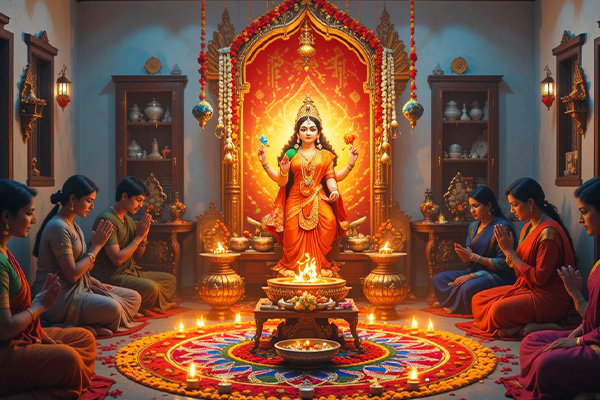
Dhanteras, observed two days before Diwali, marks an important occasion dedicated to Goddess Lakshmi. It commemorates the moment she emerged from the ocean during the Samudra Manthan. On this day, devotees clean their homes and light lamps to welcome the goddess, inviting wealth and purity into their lives. It is customary to purchase precious metals like gold or silver, symbolic of enduring prosperity. Homes are adorned with rangoli, diyas, and Lakshmi footprints, indicating her arrival. Business communities perform Lakshmi Puja, seeking her blessings for financial success in the coming year. This festival not only honours her mythological origin but also reinforces her role as the eternal provider of material and spiritual riches.
Spiritual Lessons from the Tales of Goddess Lakshmi
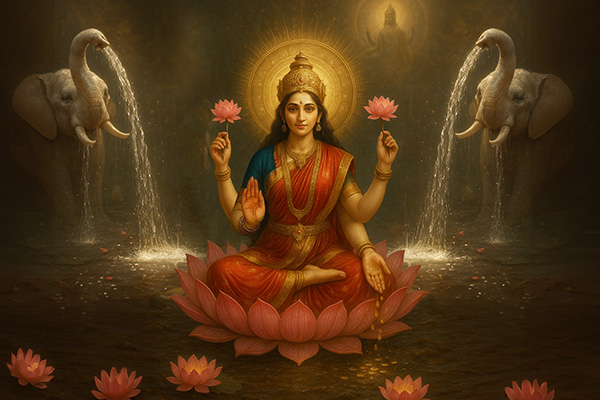
The tales of Goddess Lakshmi emphasize that true prosperity encompasses both material wealth and spiritual fulfillment. Lakshmi represents the divine energy guiding individuals to realize the four main aims of life: moral duty (dharma), desires (kama), prosperity (artha), and liberation (moksha). Her stories teach that abundance is achieved not only through external riches but also by cultivating inner qualities like purity, wisdom, creativity, strength, and self-realization.
- Lakshmi Seated on a Lotus in Muddy Waters: Symbolizes the importance of remaining pure and unaffected by negativity, and rising above challenges with serenity and grace.
- Elephants Showering Water: Represents the need to cleanse oneself of past burdens and to live fully in the present moment.
- Lakshmi’s Departure from Vishnu’s Abode: Illustrates that when one strays from their true purpose, the energy of prosperity withdraws; but when aligned with one’s higher goal, abundance naturally follows.
Lakshmi’s blessings flow to those who act with righteousness, devotion, and a pure heart, using their gifts for the greater good and striving for both worldly success and spiritual awakening.
Hrit Padma Chakra and Goddess Lakshmi

The Hrit Padma Chakra, also known as the Sacred Heart Lotus, lies just below the heart chakra and is regarded as the seat of divine love and compassion. It is described as an eight-petalled lotus where qualities such as purity, forgiveness, wisdom, and harmony blossom.
This chakra is deeply associated with Goddess Lakshmi, the goddess of abundance and auspiciousness. Just as Lakshmi represents not only material prosperity but also inner grace and spiritual well-being, the Hrit Padma Chakra symbolizes the union of outer wealth with inner fulfilment.
In Vedic tradition, the Hrit Padma is linked with the planet Venus (Shukra), which governs beauty, love, and prosperity- qualities that are also central to Lakshmi’s energy. When devotees worship Lakshmi, they also awaken the energies of the Hrit Padma, opening themselves to receive her blessings of harmony, compassion, and divine abundance.
Lakshmi Puja Vidhi at Home
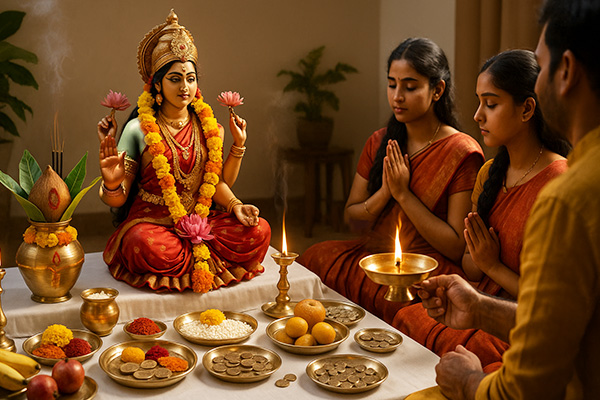
Required Materials
- Lakshmi idol or picture
- A clean red or yellow cloth for altar
- Kalash (filled with water and mango leaves)
- Coconut
- Rice, turmeric, kumkum, sandalwood paste
- Fresh flowers and garlands
- Incense sticks (agarbatti) and oil lamp (diya)
- Betel leaves and betel nuts
- Coins or currency notes
- Panchamrit (milk, curd, honey, ghee, and sugar)
- Sweets (preferably homemade)
- Lotus seeds (optional)
- Ganga water (if available)
Maa Lakshmi and 7 Mukhi Rudraksha
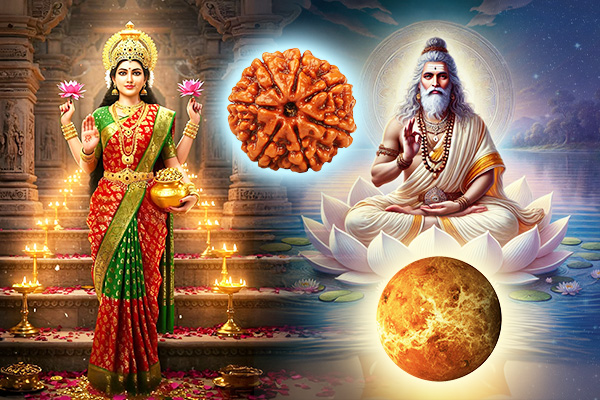
The 7 Mukhi Rudraksha is regarded as the sacred bead of Goddess Mahalakshmi, the goddess of wealth, fortune, and prosperity. Wearing this divine Rudraksha attracts good fortune, happiness, success, and abundance, while also blessing the wearer with positivity, beauty, and love.
Symbolism and Spiritual Power
This bead has seven natural clefts (mukhis) and is almost heptagonal in shape. According to the Padma Purana, the 7 Mukhi Rudraksha is closely associated with Goddess Lakshmi herself, making it a powerful tool for invoking her blessings. It is also said to be inhabited by seven mighty serpents, who protect the wearer from poison, negative energies, and harmful influences.
The Shiva Purana describes the 7 Mukhi as Ananga, stating that even a poor person becomes prosperous by wearing it. It is thus revered as a bead of contentment, protection, and abundance.
Astrological & Yogic Connection
In Vedic Astrology, the 7 Mukhi Rudraksha is believed to harmonize Venus energies, granting luxury, material comforts, and love. More importantly, it aligns the wearer’s material pursuits with their true higher purpose, ensuring that success does not lead to entanglement in maya (illusion), but to inner growth and contentment.
Connection with Hrit Padma Chakra
The 7 Mukhi Rudraksha is also linked with the Hrit Padma Chakra, the sacred lotus of the heart. By opening this chakra, it helps one realize self-worth, embrace unconditional love, and unlock limitless possibilities in both material and spiritual realms. Just like a lotus that blooms above muddy waters, this bead enables the wearer to rise above negativity and challenges, attaining balance and fulfillment.
Benefits of 7 Mukhi Rudraksha
- Attracts wealth, prosperity, and good fortune
- Brings harmony, beauty, and love into life
- Protects against negative energies and harmful influences
- Enhances confidence, positivity, and self-worth
- Helps overcome obstacles and challenges with grace
- Aligns material pursuits with divine purpose
- Invokes the blessings of Goddess Mahalakshmi
Lakshmi Puja in Diwali
Diwali, the festival of lights, holds special significance for the worship of Goddess Lakshmi, the bringer of wealth, prosperity, and auspiciousness. Among the five days of Diwali, the third day is celebrated as Lakshmi Puja, when devotees invite the goddess into their homes with lamps, rangoli, and heartfelt prayers.
On this evening, families worship Maa Lakshmi along with Lord Ganesha to seek blessings for abundance, harmony, and the removal of obstacles. Diyas (oil lamps) are lit to dispel darkness and guide the goddess into the home, while the fragrance of incense and the glow of candles create an atmosphere of purity and devotion.
Rituals of Lakshmi Puja on Diwali
- Homes and workplaces are cleaned and decorated with rangoli, flowers, and lights to welcome the goddess.
- A kalash filled with water, topped with mango leaves and a coconut, is placed near Lakshmi’s idol or picture.
- Offerings of sweets, fruits, coins, and flowers are made along with chanting of Lakshmi mantras and recitation of Lakshmi Aarti.
- Special care is taken to keep diyas burning throughout the night, symbolizing the unbroken flow of Lakshmi’s grace.
Spiritual Meaning
Lakshmi Puja on Diwali is not only about material prosperity but also about inviting inner light, purity, and wisdom into one’s life. By worshipping her with devotion, families align themselves with divine abundance, ensuring happiness, peace, and success in the year ahead.
Step-by-Step Home or Festival Puja Guide
- Purification and Setup: Clean the entire house, especially the altar area, and take a bath before beginning. Spread a clean cloth and set up the idol or image of Lakshmi, preferably facing east.
- Kalash Sthapana: Place a filled kalash near the idol, decorate it with mango leaves, and place a coconut on top. Apply kumkum and turmeric on it.
- Invocation (Avahanam): Light a diya and incense. Offer flowers and chant: “Om Shreem Hreem Shreem Mahalakshmyei Namah” Invite the goddess into your home with sincerity.
- Offerings (Upacharas): Offer sandalwood paste, kumkum, turmeric, flowers, fruits, sweets, and coins. Sprinkle rice on the idol and around the altar.
- Abhishekam (optional): Perform abhishekam of the idol with Panchamrit, then clean with water and wipe with a soft cloth. Decorate the idol with fresh clothes and ornaments.
-
Lakshmi Stotra or Mantra Chanting:
Recite Lakshmi Ashtottara Shatanamavali (108 names of Lakshmi) or chant:
“Om Shreem Mahalakshmyai Namah” (108 times) Maintain focus and devotion during chanting. - Aarti Process: Perform aarti with camphor or ghee diya while ringing a bell and singing Lakshmi Aarti: “Om Jai Lakshmi Mata, Maiya Jai Lakshmi Mata…” Move the diya in a circular motion before the idol.
- Prasad Distribution: Offer the sweets to the goddess and distribute them as prasad to family members.
- Final Prayer and Shanti Path: Conclude with a prayer for peace, prosperity, and divine blessings for the entire household.
This puja can be performed daily or during special occasions such as Diwali, Fridays, or full moon days for maximum benefit.
Lakshmi Mantras
Mahalakshmi Beej Mantra
- Hindi: ॐ श्रीं ह्रीं श्रीं कमले कमलालये प्रसीद प्रसीद श्रीं ह्रीं श्रीं ॐ महालक्ष्म्यै नमः
- English: Om Shreem Hreem Shreem Kamale Kamalalaye Praseed Praseed Shreem Hreem Shreem Om Mahalakshmyai Namah
Benefits: Chanting this mantra invokes the divine presence of Mahalakshmi, attracting wealth, prosperity, and abundance into one's life. It is particularly effective when recited during financial endeavors or while seeking material success.
Ashta Lakshmi Mantras
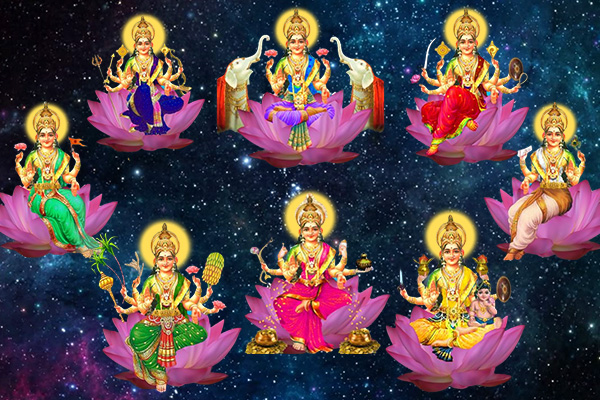
These mantras honor the eight forms of Goddess Lakshmi, each representing a different aspect of prosperity:
-
Hindi:
o ॐ आद्यलक्ष्म्यै नमः
o ॐ विद्यालक्ष्म्यै नमः
o ॐ सौभाग्यलक्ष्म्यै नमः
o ॐ अमृतलक्ष्म्यै नमः
o ॐ कामलक्ष्म्यै नमः
o ॐ सत्यलक्ष्म्यै नमः
o ॐ भोगलक्ष्म्यै नमः
o ॐ योगलक्ष्म्यै नमः -
English:
Om Adya Lakshmyai Namah
Om Vidya Lakshmyai Namah
Om Saubhagya Lakshmyai Namah
Om Amrit Lakshmyai Namah
Om Kam Lakshmyai Namah
Om Satya Lakshmyai Namah
Om Bhoga Lakshmyai Namah
Om Yoga Lakshmyai Namah
Benefits: Reciting these mantras helps in attaining comprehensive prosperity, including spiritual wisdom, courage, fertility, and success in various life endeavors.
Lakshmi Kubera Mantra
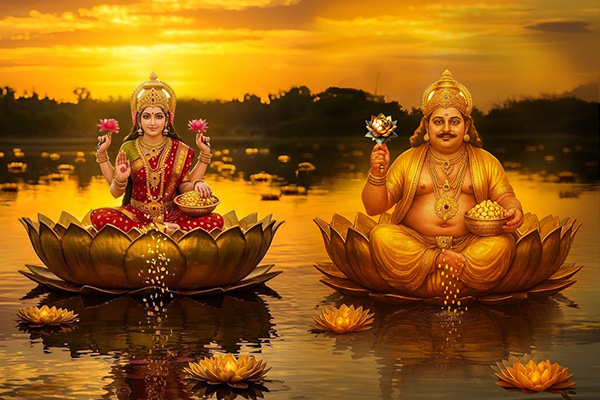
- Hindi: ॐ ह्रीं श्रीं क्लीं श्रीं कुबेराय अष्टलक्ष्मी मम गृहे धनं पुरय पुरय नमः
- English: Om Hreem Shreem Kleem Shreem Kuberaya Ashta Lakshmi Mama Grihe Dhanam Puraya Puraya Namah
Benefits: This mantra combines the energies of Goddess Lakshmi and Bhagwan Kubera, the treasurer of the gods, to attract wealth and financial stability into one's home.
Lakshmi Chalisa
The Lakshmi Chalisa is a 40-verse hymn praising the virtues and deeds of Goddess Lakshmi.
Benefits: Regular recitation bestows good health, beauty, and prosperity. It also aids in achieving success in career and personal endeavors.
Audio/Video References
Rudra Centre offers personalized puja services that include video recordings of mantra chanting and rituals, and audio or video links for Lakshmi mantras. For example, during the Ashta Lakshmi Puja and Yajna, a short video of the Sankalpa and mantra chanting is provided to the devotee.
Mahalaxmi Ashtakam | Recited by Vedic Brahmins
Powerful Ashta Lakshmi Stotram Recited by Vedic Pundits
Benefits of Worshipping Lakshmi
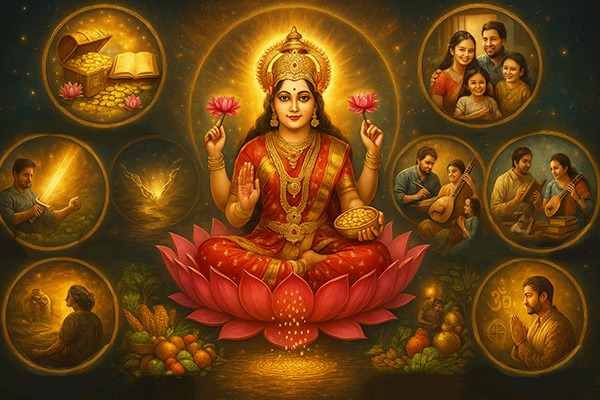
Worship of Goddess Lakshmi brings a harmonious blend of spiritual, mental, and material benefits. Spiritually, it aligns the devotee with the higher aims of life, guiding one toward self-realization, inner abundance, and fulfilment of dharma, desires, prosperity, and liberation. Mentally, Lakshmi worship cultivates wisdom, clarity, creativity, and a positive mindset, empowering individuals to overcome obstacles and make sound decisions. Materially, her blessings manifest as wealth, prosperity, good health, and overall success, ensuring growth in business, career, and personal life.
The presence of Lakshmi’s divine energy nurtures happiness, harmony in relationships, and the ability to attract new opportunities, while also fostering patience, courage, and confidence to navigate life’s challenges. Her worship is not limited to the pursuit of riches but encompasses the attainment of true wealth, qualities and resources that elevate both the individual and the community.
Most important benefits of worshipping Lakshmi:
- Attracts wealth, prosperity, and material abundance
- Bestows wisdom, intelligence, and clarity of thought
- Promotes happiness, harmony, and bliss in family life
- Enhances creativity, talents, and success in endeavors
- Ensures good health and longevity
- Removes obstacles to financial growth and stability
- Brings victory, confidence, and courage
- Fosters spiritual awakening and inner fulfillment
- Provides nourishment, food, and overall well-being
- Supports righteous living and fulfillment of life’s higher purpose
Temples dedicated to Goddess Lakshmi
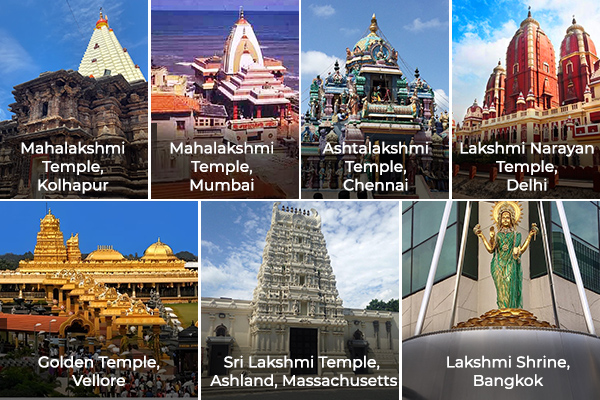
Temples dedicated to Goddess Lakshmi are found throughout India and abroad, serving as important centres for worship and pilgrimage. These temples often feature distinctive regional architecture, intricate carvings, and lotus motifs symbolizing purity and prosperity. Key festivals such as Diwali, Varalakshmi Vratam, and Maha Lakshmi Vrat draw large numbers of devotees for special rituals and celebrations.
Major Lakshmi temples in India include the Mahalakshmi Temple in Kolhapur, a prominent Shakti Peetha known for its historical significance and Chalukya architecture, and the Mahalakshmi Temple in Mumbai, famous for its spiritual atmosphere. The Ashtalakshmi Temple in Chennai stands out for its multi-level design honouring all eight forms of Lakshmi. Other notable sites are the Lakshmi Narayan Temple in Delhi and the Golden Temple in Vellore. Internationally, the Sri Lakshmi Temple in Ashland, Massachusetts, and the Lakshmi Shrine in Bangkok are well known. These temples remain focal points for devotees seeking the blessings of wealth and well-being.
Lakshmi Presence in Other Traditions
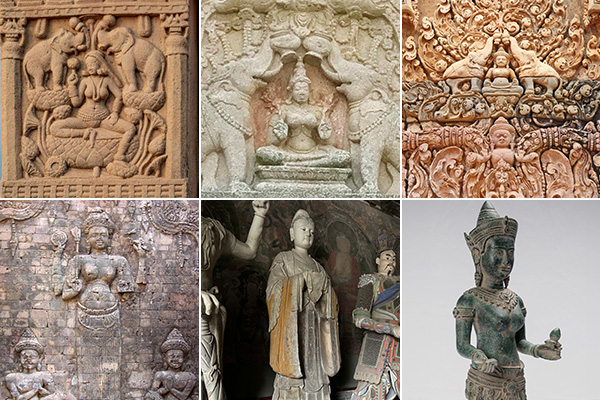
Goddess Lakshmi’s influence extends well beyond Hinduism, shaping spiritual and cultural traditions in Buddhism, Jainism, and Southeast Asia. In Buddhism, Lakshmi appears as a goddess of abundance and fortune, reflected in ancient stupas and cave temples. In Mahayana and Tantric Buddhist texts, she is invoked as Shri, the provider of happiness and well-being, offering monks the necessities to expound dharma. In Tibetan Buddhism, Vasudhara mirrors Lakshmi’s qualities as a deity of wealth. In Chinese Buddhism, she is known as Gongdetian or Jixiang Tiannü, the auspicious goddess, enshrined in monasteries and honored as a protector and benefactor. Her mantra is recited in daily liturgies, and she is considered the sister of the guardian deity Vaisravana.
In Jainism, Lakshmi is venerated as the goddess of wealth, auspiciousness, and prosperity. She appears in ancient Jain texts and is a central figure in temple iconography, often depicted seated on a lotus and flanked by elephants, echoing her Gaja Lakshmi form. Jain festivals like Dhanaterasa and Diwali include her worship, and her imagery is found in major Jain temples such as Sarnath, Udaygiri, Khajuraho, and Mount Abu. Jain tradition emphasizes her role as both a bestower of fortune and an elusive figure, highlighting the need for ethical conduct to attract her blessings.
Lakshmi’s presence is prominent in Southeast Asia, especially in Cambodia, where she is depicted in temples like Angkor Wat and Banteay Srei. Her iconography,
lotuses and symbolizing prosperity, reflects the Khmer Empire’s aspirations for abundance and success. Lakshmi was revered by royalty, merchants, and commoners, and her influence extended into commerce and daily life. Even after the rise of Buddhism, her legacy endures in art, folklore, and modern practices, with her image symbolizing prosperity in homes and markets.
Comparative mythology draws parallels between Lakshmi and goddesses like Aphrodite in Greek tradition. Both are associated with beauty, abundance, and the sea, and both embody ideals of femininity, prosperity, and nurturing. Their stories highlight universal themes of love, fortune, and the balance between material and spiritual wealth, showing that the reverence for abundance and beauty transcends cultural boundaries.
Rudra Centre Lakshmi Products & Services
Brass Laxmi Idols:
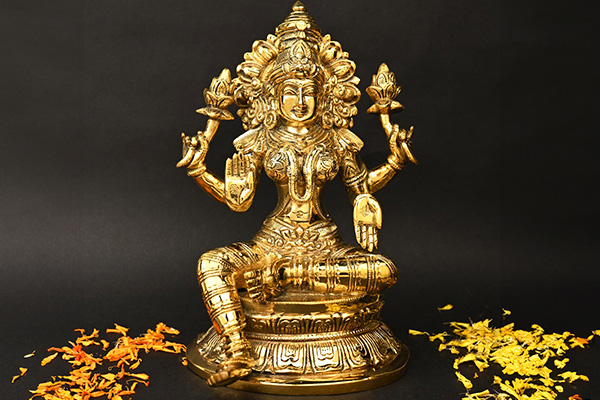
Finely crafted brass idols of Lakshmi in various forms, ideal for home altars to attract prosperity and good fortune.
Mahalakshmi Yantra:
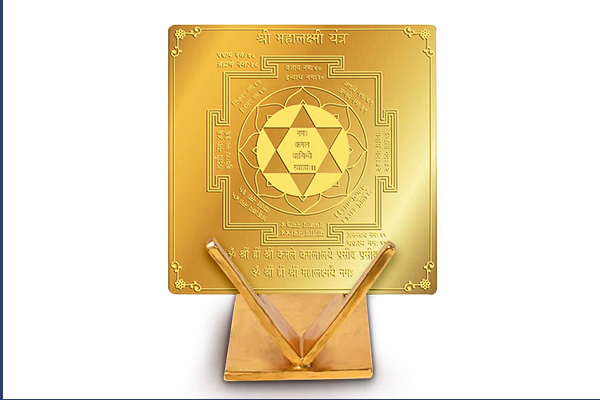
Energized yantra etched on brass, used for invoking Lakshmi’s blessings for wealth and fulfilment of desires.
Laxmi Charan Paduka:
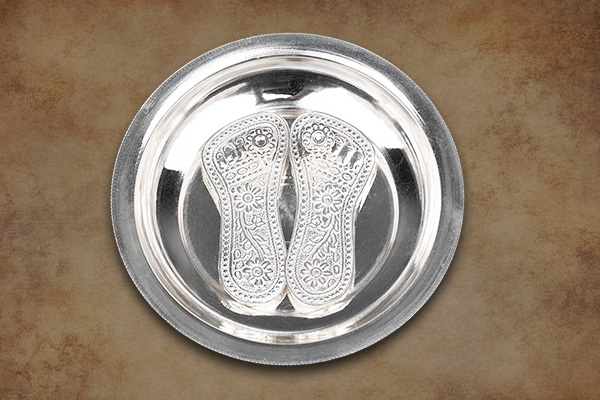
Divine footprints of Lakshmi carved in silver, symbolizing her presence and bringing luck and abundance to homes and businesses.
Mahalakshmi Pendants:
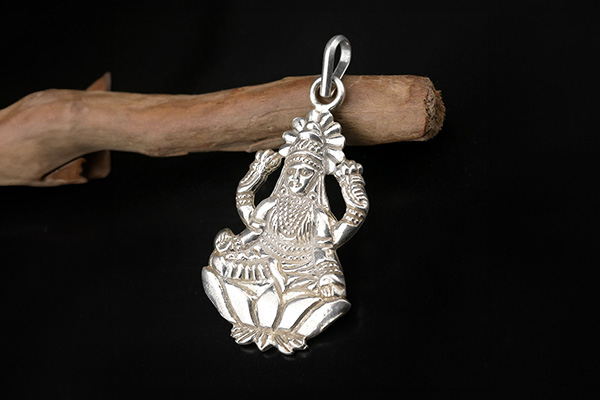
Pendants in silver and gold featuring Lakshmi’s iconography, worn for attracting prosperity and spiritual protection.
7 Mukhi Nepal Rudraksha:
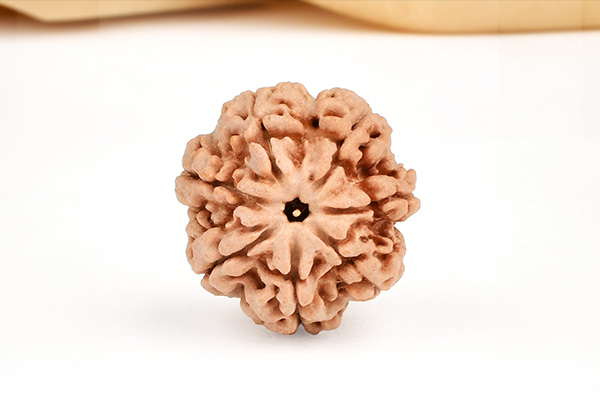
Blessed by Goddess Mahalakshmi, attracts wealth, prosperity, harmony, and success while aligning the wearer with divine abundance.
Lakshmi Puja Kit:

Complete set of high-quality ingredients including Lakshmi idol, kumkum, sandal paste, sacred water, and altar cloth, designed for performing an elaborate Lakshmi Puja at home.
Lakshmi Puja for Wealth and Prosperity:
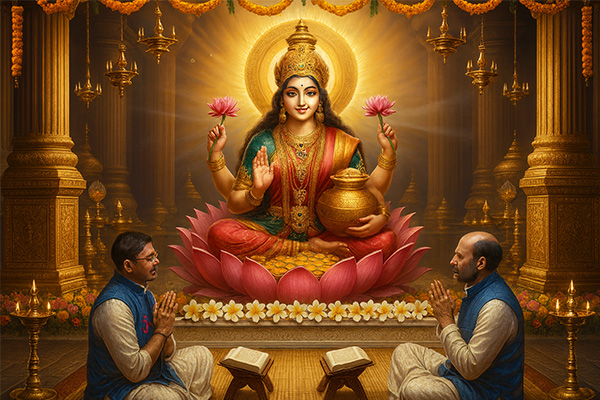
Buy Lakshmi Puja for wealth & prosperity
Vedic puja invoking Goddess Lakshmi for abundance, financial stability, and removal of obstacles, performed by expert priests with options for extended rituals.
Laxmi Narayana Puja and Yajna:
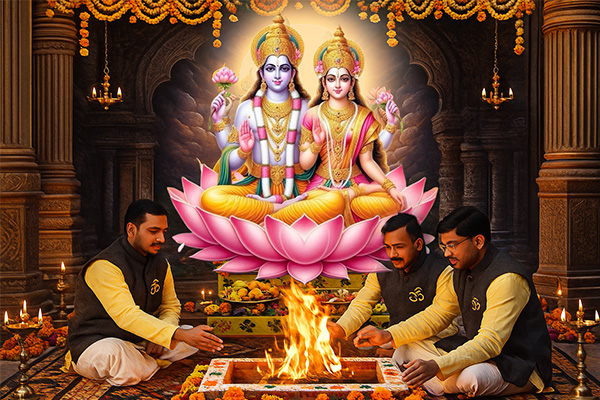
Buy Laxmi Narayana Puja & Yagna
A comprehensive ritual with 11000 chants, Kalash Sthapana, and yajna, performed as per Vedic tradition, with live participation and prasad delivery.
Conclusion: The Lasting Light of Prosperity and Inner Fulfillment
Goddess Lakshmi stands as the timeless embodiment of abundance, auspiciousness, and spiritual grace. Her presence in homes, temples, and hearts inspires not only the pursuit of material prosperity but also the cultivation of wisdom, compassion, and ethical living. Lakshmi’s blessings are most potent when sought with sincerity, humility, and a pure heart, reminding us that true wealth lies in the harmony of outer success and inner peace. Across cultures and centuries, her influence has shaped traditions, uplifted communities, and guided individuals toward a life of purpose and fulfillment. In honoring Lakshmi, we embrace a vision of prosperity that transcends riches, leading us to a deeper realization of life’s highest values and the joy of sharing our blessings with the world.


-in-Astrology.jpg)
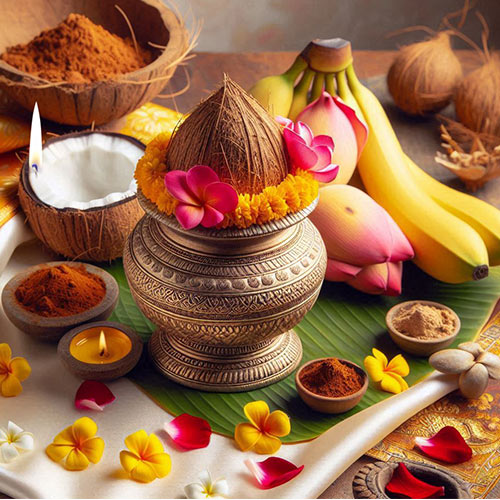
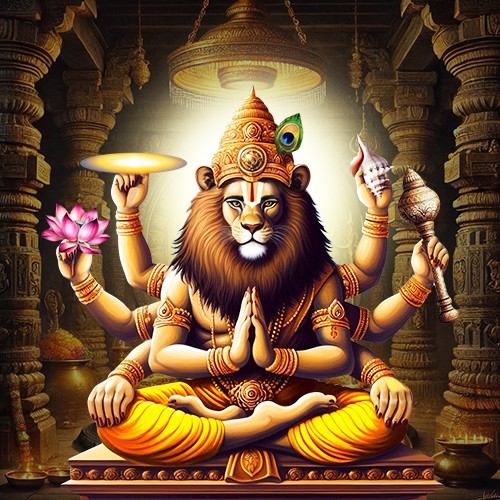
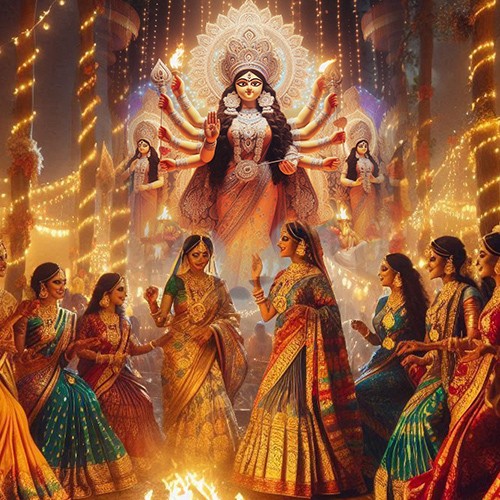
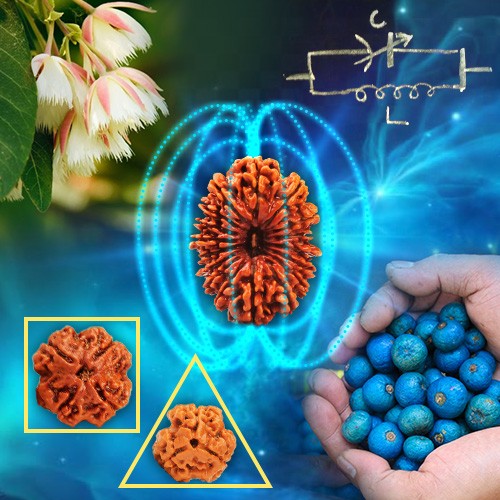

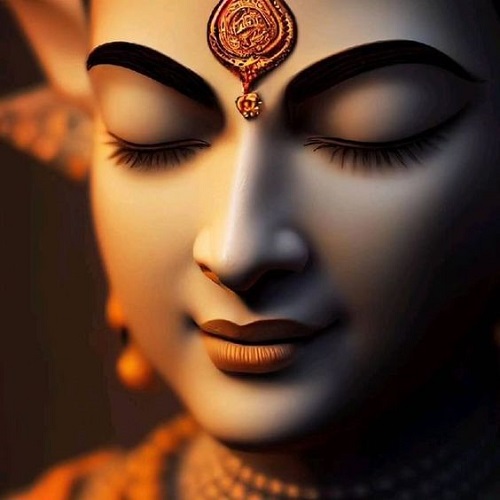
.jpg)
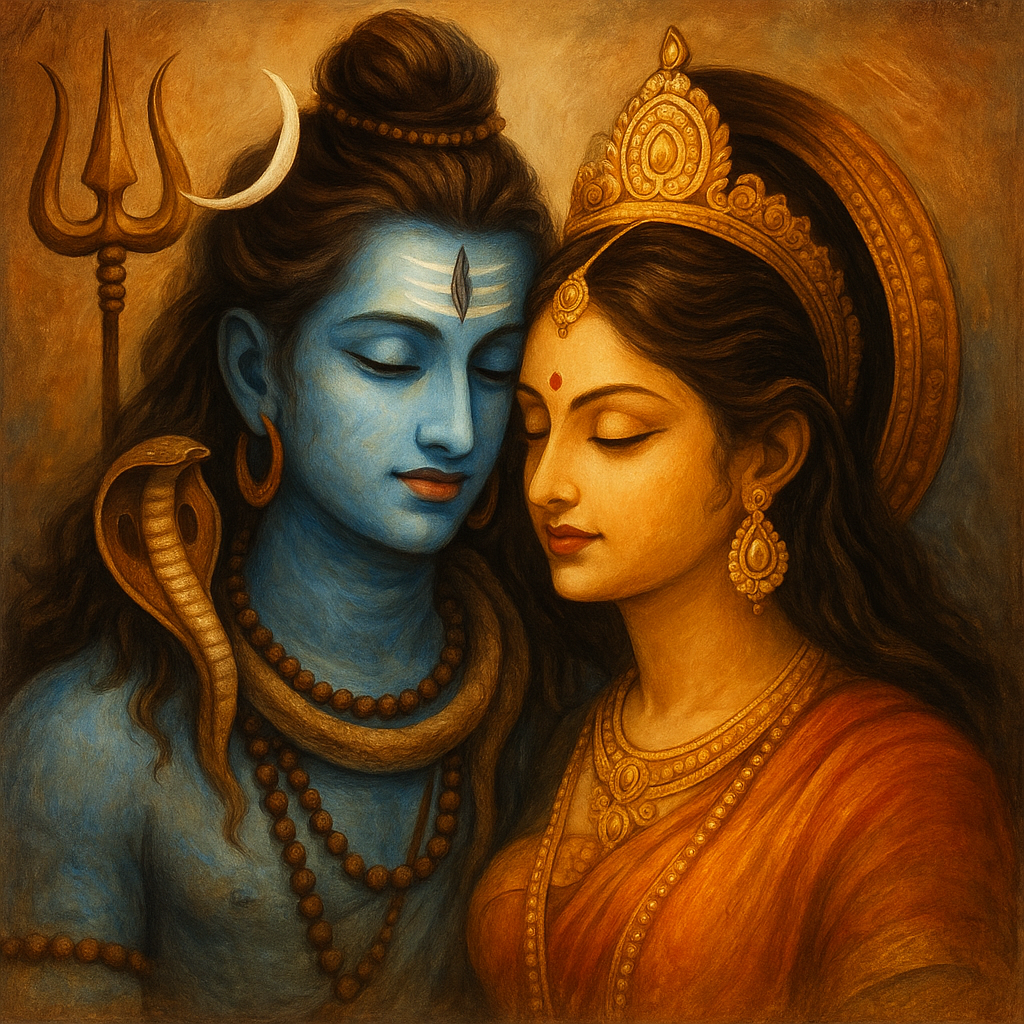
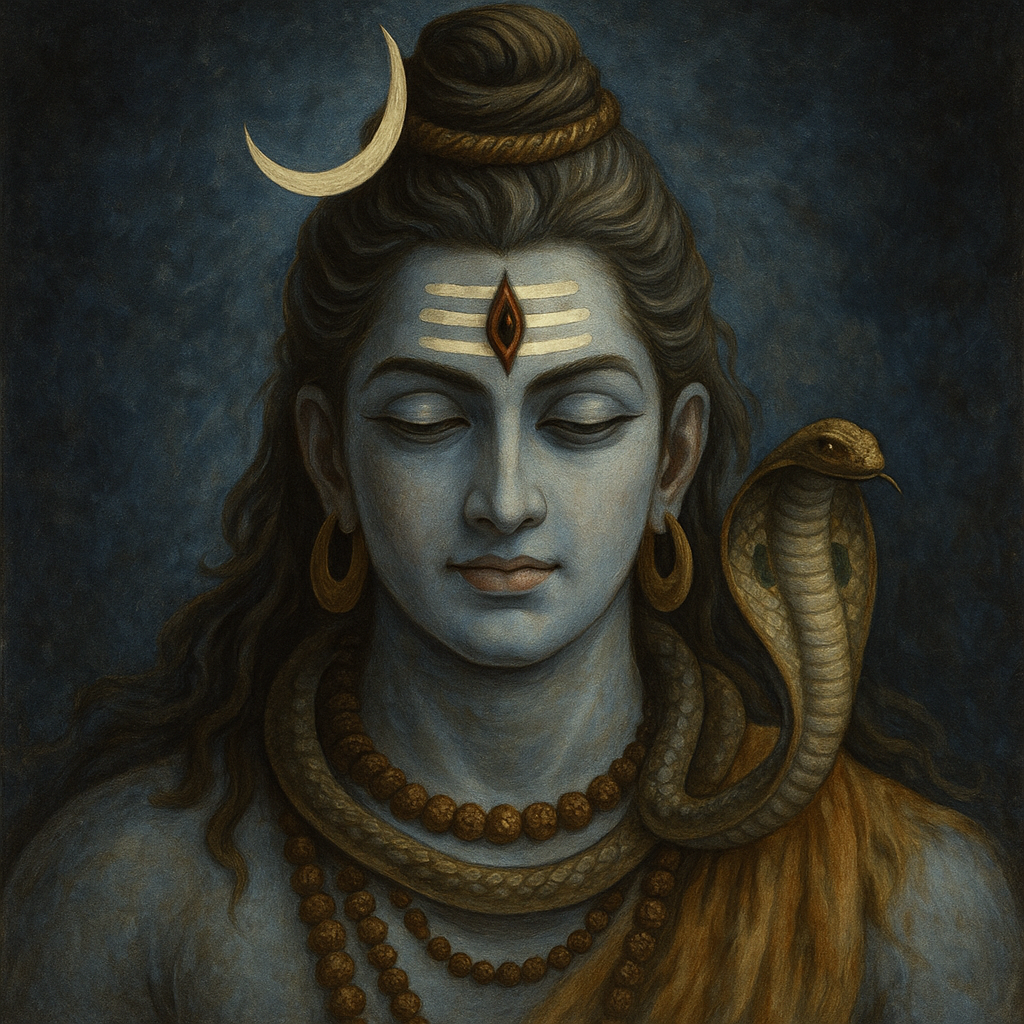
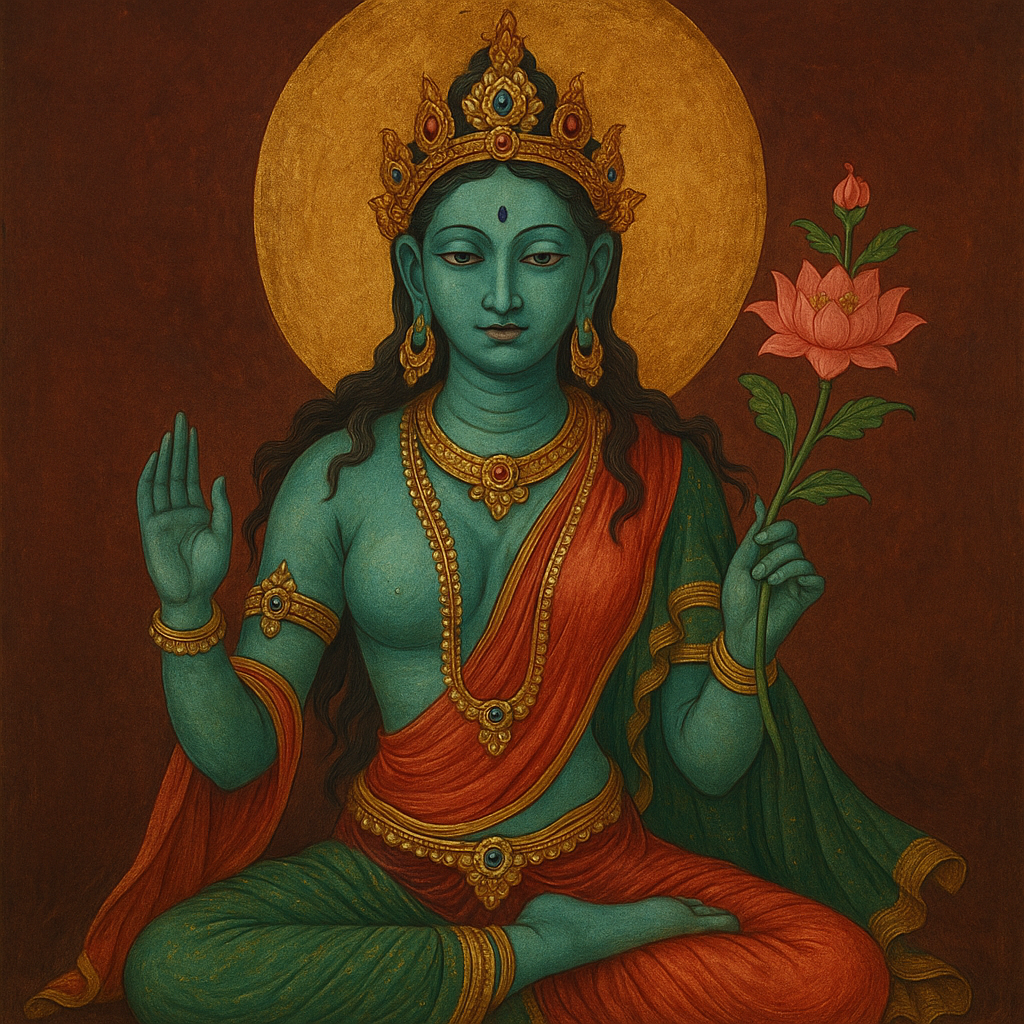
Mbuyiselo Tshabalala Ntsebeng
|May 28, 2024
I love Goddess Lakshmi and I wish to have her idol one day